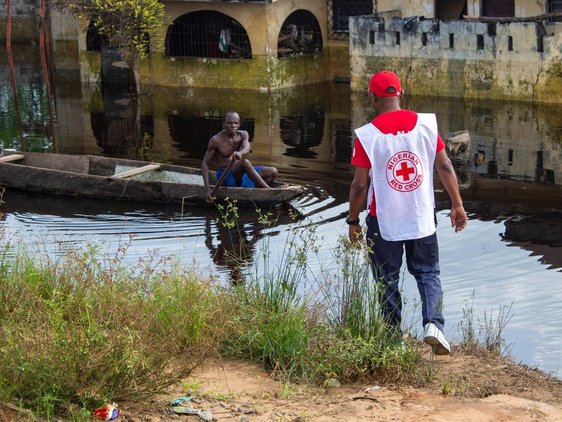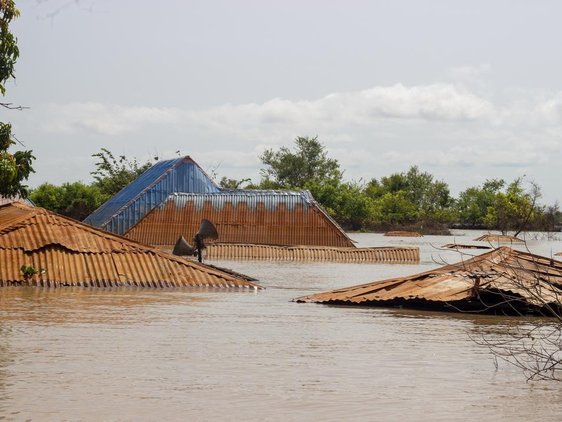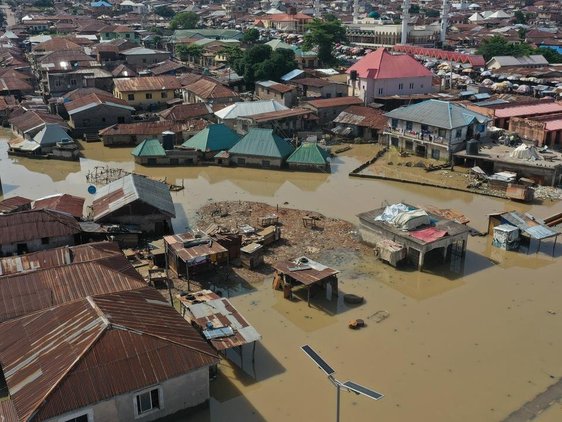Simplified Early Action Protocols: a lighter approach to anticipatory action
National Red Cross Red Crescent Societies looking to implement anticipatory action now have another modality they can use: Simplified Early Action Protocols (EAPs). Having been launched by the IFRC in June 2022, the Nigeria Red Cross Society recently became the first National Society to have its Simplified EAP, for floods, approved. Two further Simplified EAPs – for cold waves in Kazakhstan and for floods in Djibouti – have since been approved, giving these National Societies preagreed funds to act in advance of these hazards.
The IFRC’s Disaster Response Emergency Fund (DREF) has been funding EAPs since 2018. However, to develop these EAPs, National Societies usually require financial and technical support from partners. The Simplified EAPs are, as the name implies, easier to develop, being based on the National Society’s own capacity. “We believe a National Society should be able to put this plan together independently,” explains Gabriel Nashon, senior disaster management officer at the IFRC.
“The IFRC decided to launch this new modality – a simpler, lighter approach to anticipatory action – to encourage more National Societies to act in advance of a hazard,” continues Melanie Ogle, IFRC’s senior officer for capacity strengthening for the anticipatory pillar of the DREF. “We believe that this new modality will make anticipatory action more accessible and will enable the IFRC network to scale up its ambition to do more anticipatory action.”
Alongside the three Simplified EAPs already approved, others have been submitted for approval, including from Ghana and Tanzania, and several more are in development. “I think that we can say that the initial uptake has been very good,” confirms Gabriel.

Floods in Nigeria have damaged sections of the East-West Highway which connects multiple states in southern Nigeria causing disruption to supply chain and other essential services © IFRC/Aduratomi Bolade

Community members are only able to get around by boat in Ahoada East local government due to the devastation caused by the flood. © IFRC/Aduratomi Bolade

Houses which have been submerged by flood water in Lokoja, Kogi state, north central Nigeria. © IFRC/Aduratomi Bolade

Aerial view of parts of Lokoja, capital of Kogi state, north central Nigeria, affected by floods. © IFRC

A victim of the recent floods in Rivers state, Nigeria at a camp for internally displaced people in Ahoada East local government talking to the a Red Cross volunteer about the needs of residents of the camp. © IFRC/Aduratomi Bolade

Floods in Nigeria have damaged sections of the East-West Highway which connects multiple states in southern Nigeria causing disruption to supply chain and other essential services © IFRC/Aduratomi Bolade
Community members are only able to get around by boat in Ahoada East local government due to the devastation caused by the flood. © IFRC/Aduratomi Bolade
Houses which have been submerged by flood water in Lokoja, Kogi state, north central Nigeria. © IFRC/Aduratomi Bolade
Aerial view of parts of Lokoja, capital of Kogi state, north central Nigeria, affected by floods. © IFRC
A victim of the recent floods in Rivers state, Nigeria at a camp for internally displaced people in Ahoada East local government talking to the a Red Cross volunteer about the needs of residents of the camp. © IFRC/Aduratomi Bolade
Simplified EAPs: a quick guide
Simplified EAPs can be used for above average or extreme events, and for both weather and non-weather events.
The trigger or threshold at which they are activated is simpler than for full EAPs, and so easier for National Societies to monitor.
The early actions outlined in a Simplified EAP must target a minimum of 2,000 people.
Simplified EAPs have a two-year lifespan, after which the plan is revised, if necessary, and reapproved.
As with full EAPs, Simplified EAPs are developed in advance of a hazard and have preapproved funding from the DREF. Funds of up to 200,000 Swiss Francs (212,678 US dollars / 203,869 euros) are available.
These funds can be used for annual readiness and preposition activities, as well as early actions.
After a National Society has activated its Simplified EAP, it can access more funding from the DREF to support a response operation for the same hazard event.
However, a National Society cannot have a Simplified EAP and a full EAP at the same time for the same hazard. The Nigeria Red Cross Society can have a Simplified EAP while it works on a full EAP for floods; however, National Societies are not obliged to transition to a full EAP unless they want to.
A vital tool to combat growing threats
Approval of the first Simplified EAP was a significant milestone in the IFRC’s efforts to scale up anticipatory action, but this occurred as Nigeria battled extraordinary floods that have affected much of the country and killed more than 600 people. Having only recently been approved, it was not possible to activate the Simplified EAP for Floods this year. However, the plans are now in place to act ahead of the next flooding season.
“The Nigeria Red Cross Society did request a DREF allocation in advance of the peak of the floods to do anticipatory action,” explains Melanie “and complemented the early actions with a further DREF allocation and an emergency appeal, in order to scale up response to these unprecedented floods.”
For further information about Nigeria’s Simplified EAP, please contact Gabriel Nashon, senior disaster management officer, IFRC, or Benson Agbro, director - disaster management, Nigeria Red Cross Society.
For further information about the IFRC’s modalities for anticipatory action, please contact Nazira Lacayo, senior officer for the anticipatory pillar under the DREF, or Melanie Ogle, senior officer for capacity strengthening.
Note: the photos used with this article are from the Nigeria Red Cross Society’s disaster response to the 2022 floods. They are not supported by the Simplified EAP.
